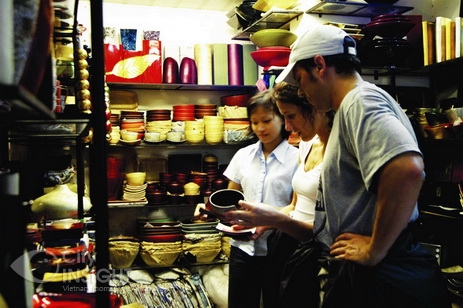Lacquer Village: Preserving Tradition

Ha Thai Village is known as Lacquer Village because of its lacquer painting tradition that is remarkably 250 years old. The village is a simple, provincial setting with almost 700 families or about 3,500 local residents, 90 percent which are into the tradtional professions as their primary means of livelihood and skill.
Ha Thai Village is located near the National Highway 1A, or about 30 kilometers South of Ha Noi. Like any rural area, the place is filled with rich, green fields and animals like carabaos roaming around or helping the residents with their chores. And since lacquer painting is the main source of living, almost every household in the village has a lacquerware workplace and a shop to both make and sell their products.
Lacquerwork in Vietnam first came from China, which was introduced into the said country centuries ago. Later on, the French also introduced Western techniques and paintings after the Indochina Fine Arts College was established in Ha Noi in 1925. Back then, lacquer style was used in paintings as a new art form. The products were usually traditional, depicting scenes or beauty of nature. In the 17th century, objects of worship were lacquered with red and trimmed with gold. In the 1930s, graduate students from the college discovered that materials like egg shells, bamboo, and sea shells can be used for the craft. A new polishing technique which enhances beauty of the subject was also introduced.
Black, brown and red were the usual colors for lacquerware when it first started. But today, variety is injected into the art, with lighter and even more fun colors like white, blue, green and yellow used for also a more contemporary look. Wood, bamboo and rattan were the traditional materials used for lacquer. Today, composite and ceramics are also utilized. And though nature as a subject never seems to go out of style even in other art forms, today more modern and updated themes are certainly applied.
Lacquer paint, which is actually resin of the cay son or lacquer tree, comes from Northern Phu Tho Province. Creating lacquer products can be quite tedious. There are different phases of doing so. First, objects that are going to be lacquered are covered with pure cotton cloth. Then, they are coated with paint to protect from shrinkage and warping. The products are decorated by hand after. For the final touch, they are then polished. Each item must have 12 layers of lacquer. Enable for the paint to dry quickly, the fisnished product has to be stored in a cupboard and kept away from wind and high humidity. Spring and early summer rainy days are considered the ideal time for lacquer painting. If properly done, a well-lacquered product should be able to keep its color for an amazing 400 years.
Now is the best time to visit the village since artisans are getting ready for the Handicraft Products Fair to be held in Ha Noi on October. This means that although everyone is busy working, you are assured of being able to see the best products wherein artists are trying to perfect their craft for the said big event. Bowls, plates, trays, bamboo vases, pottery, boxes, decorative pictures, and even chopsticks are just some of the lacquered items you will find during this time, guaranteed to bear the best designs there are.
In the 1990s, lacquer painting exports faced a downturn due to fluctuation in East European markets. But since Ha Thai Village is known not only locally but in fact globally for its world-class lacquer designs, the small, unassuming yet exceptional place will continue to work and perfect their craft to preserve their reputation for creating and being the best lacquer painters in the world.









